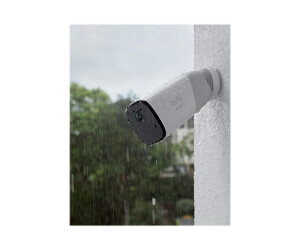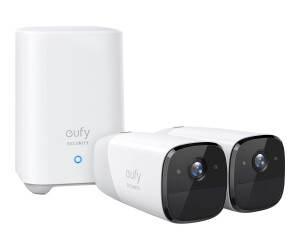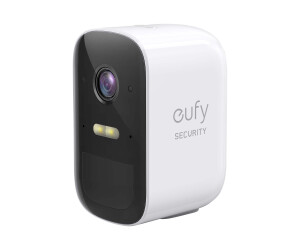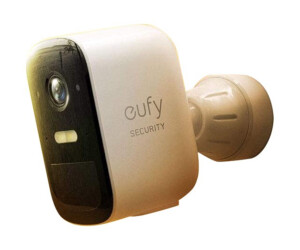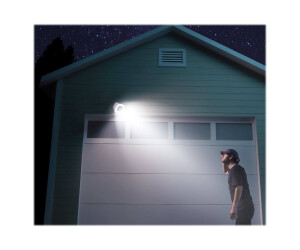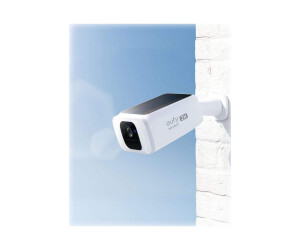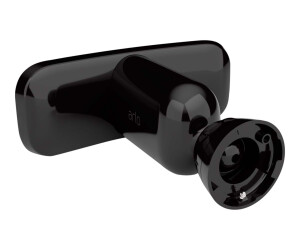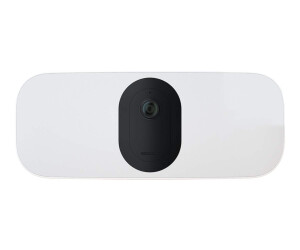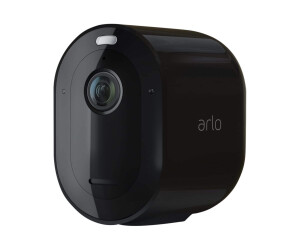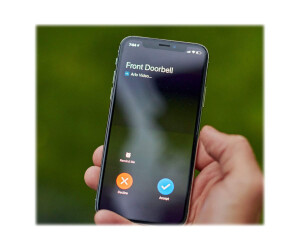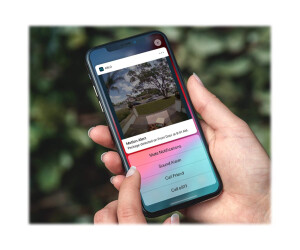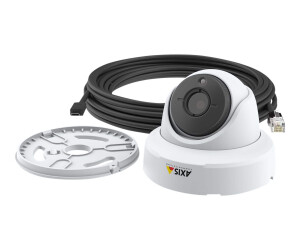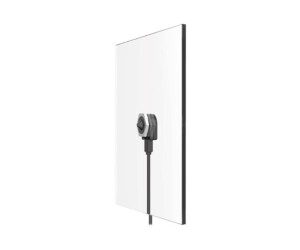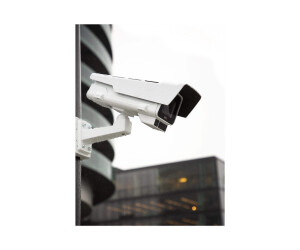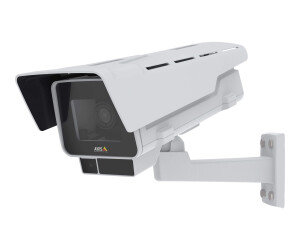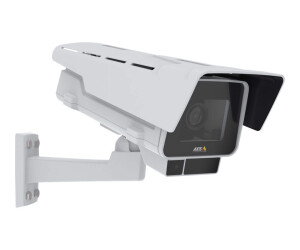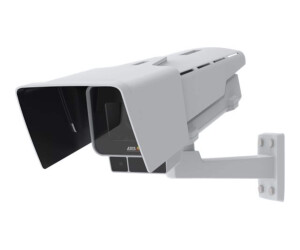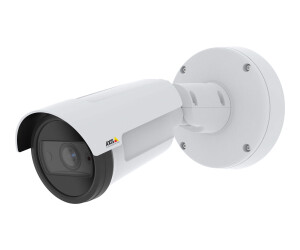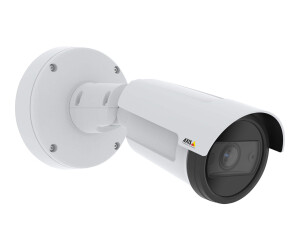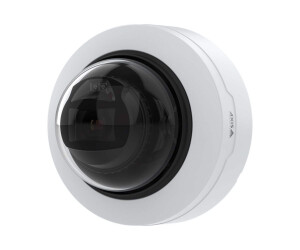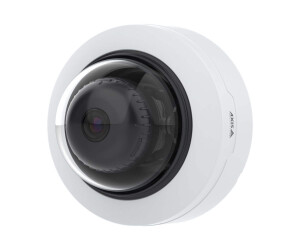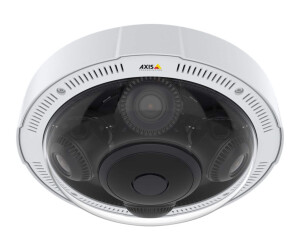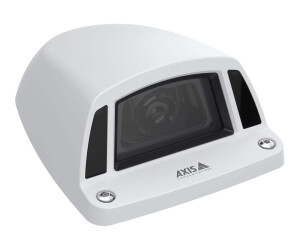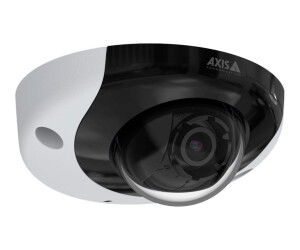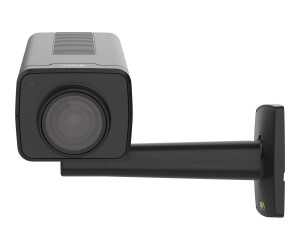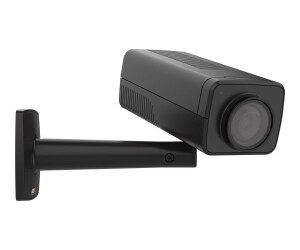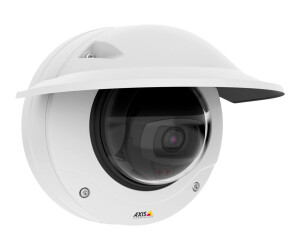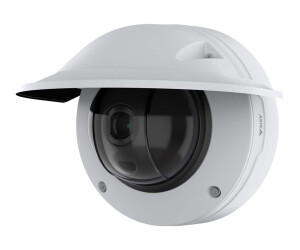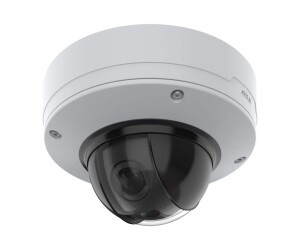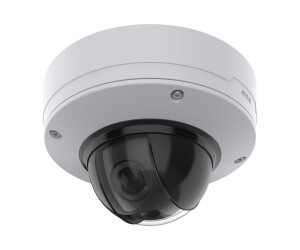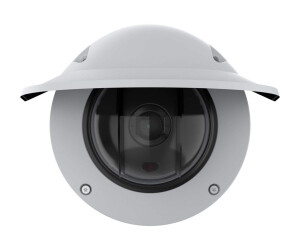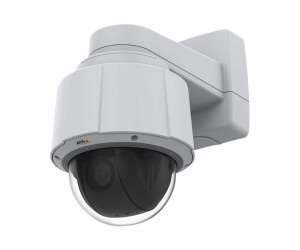- /
- Computersystems
- /
- Networking
- /
- Network Cameras
Network Cameras
Network Cameras
In many environments, network cameras are already in daily use, and the wide selection of different models offers numerous possibilities. Therefore, we also offer IP cameras that you can easily install and set up to keep an eye on the desired areas at all times. The acquisition can be worthwhile not only for companies but also for individuals who want to monitor their home when no one is there.
How do the network cameras of the individual manufacturers differ?In our range, you will find a diverse selection, with each manufacturer usually offering several product lines. The most obvious difference is whether the camera can be controlled, allowing, for example, rotation, or if it is mounted fixedly and then shows a predetermined image. In addition, some cameras have infrared sensors and other extras to provide a usable image even at night.
Another important point is, of course, the image quality, as network cameras also differ technically in their capabilities. While one model only generates a 720p data stream, recording in 4K resolution may already be possible with another product. Many cameras can also obscure certain parts of the image, which may be necessary to avoid unauthorized recording.
Also, be sure to consider the intended use of the camera. In particular, the distinction between outdoor and indoor use is important. If the network camera is intended to monitor the outdoor area of your company, it must be weatherproof. Some models can also be retrofitted accordingly, usually using suitable housings.
Many manufacturers also equip their network cameras with features such as motion detection. Cloud storage and other apps for access are also frequently encountered. Which of these features are important to you always depends on the requirements, especially since additional devices for data storage and management of the cameras are often used. The latter can often be taken over by NAS systems.
What are the advantages of used network cameras?In addition to the lower price, you also benefit from the respective range of functions with used and refurbished IP cameras. In our range, you will also find a variety of accessories to equip the camera for the respective application and to expand its functionality. Systems for management are also part of our range, so you can get everything from one source and start installation and setup directly.
So, whether you need a monitoring solution for your private household or your company, just contact us. We will be happy to offer you suitable products and assist with planning. Since the cameras rely entirely on communication in the network, a powerful network infrastructure is, of course, also required. PoE support can also be helpful for the latter to supply the IP cameras directly with power via a network cable.
Network cameras, also known as IP cameras, are a type of surveillance camera that are connected to the internet or other networks through a network. Unlike traditional CCTV cameras that use analog signals to record videos, network cameras use digital signals to capture and transmit videos. These cameras are extremely versatile and offer a range of features that make them ideal for a variety of applications, from monitoring homes or offices to security surveillance of large businesses and public places.
Network cameras are capable of recording and transmitting high-quality videos in full HD or even 4K resolution. They have built-in processors and memory to process and store videos in real-time, allowing users to view live feeds from anywhere with an internet connection. Network cameras can also be equipped with intelligent features such as motion detection and people counting to alert users to potential threats and collect accurate data on visitor flows.
Another advantage of network cameras is their easy setup and installation. As they are connected to a network, they can be monitored from anywhere with an internet connection. Users can also easily connect multiple cameras to create a comprehensive surveillance solution for large areas. In addition, network cameras offer high flexibility in placement and installation as they can be operated wirelessly and with Power over Ethernet (PoE).
Network cameras are also extremely reliable and secure. Most models are equipped with encryption and authentication features to ensure the security of recorded videos and data. Furthermore, network cameras can be controlled with special software tools and apps that allow users to access live feeds and recordings from anywhere.
There are different types of network cameras that can be distinguished based on their application and functions.
Dome cameras:
Dome cameras are a type of network camera that have a hemispherical cover and are therefore also known as dome cameras. These cameras are ideal for indoor use due to their discreet design and inconspicuousness. They can be mounted on ceilings or walls, making them flexible and versatile.
The hemispherical cover of the dome camera protects the camera lens from vandalism, sabotage, and weather conditions such as dust and moisture. This makes them well suited for use in public areas such as airports, train stations, shopping malls, and other public facilities. Dome cameras are also popular in businesses and private homes as they allow for inconspicuous surveillance.
Dome cameras are typically equipped with a pan-tilt function that allows for 360-degree surveillance. Some models also come with zoom functions that allow users to zoom in on specific areas and details.
Another advantage of dome cameras is that they are difficult to detect due to their design. The hemispherical cover of the camera prevents potential perpetrators from determining which direction the camera is facing. This increases the deterrence of crime as perpetrators do not know if they are being monitored.
Dome cameras can be either wired or wireless, with wireless models communicating via Wi-Fi or other wireless connections. Most dome cameras are also equipped with motion detection functions that allow for an alert to be received when movements are detected. This allows users to respond to potential threats and act quickly to resolve security issues.
Bullet Cameras:
Bullet cameras are a type of network camera designed for outdoor use due to their elongated, cylindrical design. They can be mounted on walls or poles and are rugged and weather-resistant, making them ideal for use in environments with the harshest conditions, such as outdoors, on construction sites, and in industry.
Bullet cameras are usually equipped with a pan and tilt function that allows for horizontal or vertical surveillance. Some models also have a zoom function that allows users to recognize details and zoom in on specific areas. These features allow users to monitor large areas while recording accurate details.
Bullet cameras are typically equipped with weather-resistant covers that protect them from environmental factors such as rain, snow, and dust. This allows them to be used in environments that are not suitable for other cameras. The weather-resistant cover also protects the camera optics from weather and damage caused by vandalism or sabotage.
Bullet cameras are typically equipped with infrared LEDs, which allow for viewing in low light conditions. This also enables them to provide excellent surveillance at night, giving users a sense of security. Some models also have motion detection features, allowing users to receive an alert when movements are detected. This allows users to act quickly and respond to potential threats.
Bullet cameras are easy to install and maintain. They can be mounted on walls or poles and require very little space. Most models are PoE-capable (Power over Ethernet), which means they can receive power and data over the same cable. This simplifies installation and reduces the need for additional cables and outlets.
Pan-Tilt-Zoom Cameras (PTZ):
Pan-tilt-zoom cameras, also called PTZ cameras, are a type of network camera that provides comprehensive monitoring with the ability to remotely control and zoom in on specific areas. The cameras are able to rotate around their axes (pan), tilt (tilt), and zoom (zoom) to cover a wide area and zoom in on specific areas. This makes PTZ cameras an ideal choice for monitoring large areas such as shopping malls, airports, industrial areas, and stadiums.
The pan function allows the PTZ camera to rotate horizontally 360 degrees, while the tilt function allows it to tilt vertically 180 degrees. This allows the camera to pan in all directions and cover critical areas without physically moving it. These features offer greater flexibility and more comprehensive monitoring than stationary cameras.
The zoom function of PTZ cameras allows users to zoom in on specific areas to recognize details. This is particularly useful for identifying objects or people from a distance. Most PTZ cameras are equipped with optical zoom, which maintains clear image quality when the camera zooms closer to the target object.
Most PTZ cameras have motion detection features, allowing users to receive an alert when movements are detected. This allows users to act quickly and respond to potential threats. Most PTZ cameras also have a night vision function that allows them to see in low light conditions.
Most PTZ cameras are PoE-capable, which means they can receive power and data over the same cable. This simplifies installation and reduces the need for additional cables and outlets. PTZ cameras can be remotely controlled either through a joystick or through software installed on a computer or mobile device.
Fisheye Camera:
Fisheye cameras, also known as panoramic cameras, have a special lens that enables an extremely wide field of view of 180 to 360 degrees. This type of camera is ideal for applications where comprehensive surveillance is required, such as in shopping malls, schools, museums, airports, and other public places.
The lens of the fisheye camera is typically spherical or aspherical in shape to cover the entire field of view. Images are generated either through the use of multiple sensors or by distorting the image to enable a 360-degree view. The distorted view is later corrected using special software.
Another advantage of fisheye cameras is their high resolution and image quality. Since they cover a large field of view, they can replace multiple individual cameras and save costs. Installation and maintenance are also easier as fewer cameras are required.
However, there are also disadvantages to using fisheye cameras. The distortion of the image can lead to distortion of perspective, making it difficult to identify people or objects. They also require more bandwidth and storage space to process the large amount of data.
Fisheye cameras are also available in various versions, such as fixed-mount cameras or PTZ cameras with a 360-degree field of view. Some cameras also have an intelligent function that enables the viewer to zoom in on a specific area of the image by clicking on it.
Thermal Camera:
Thermal cameras, also known as infrared cameras, use thermal imaging technology to detect and display objects. Unlike conventional cameras that use visible light, thermal cameras use infrared radiation emitted by objects.
Thermal cameras are particularly useful for monitoring environments with poor lighting conditions or low visibility, such as in tunnels, factories, warehouses, and other industrial applications. They can also be used to search for people in wooded areas or to detect animals in the wilderness.
One of the main advantages of thermal cameras is their ability to capture objects in absolute darkness. They can also see through smoke, fog, and dust, which is a challenge for conventional cameras. Thermal cameras can also be used for monitoring rooms where no light is needed to ensure privacy.
Thermal cameras are available in various versions, from portable handheld devices to stationary cameras. Most cameras have automatic temperature correction to ensure accurate representation of heat distribution. There are also cameras with different resolutions to increase the detection range and accuracy of thermal imaging.
Another advantage of thermal cameras is that they do not require lighting to capture images. This means they can also be used during power outages or other emergencies.
However, thermal cameras also have some disadvantages. One challenge of using thermal cameras is that they require some training and experience to use them effectively and interpret them correctly. They can also trigger false alarms due to their high sensitivity to heat sources such as the sun.
Body cameras:
Body cameras are wearable cameras worn by law enforcement officials, security personnel, or other professions to record evidence or monitor individuals. The cameras are usually attached to clothing to allow for hands-free operation and can also be worn with a harness or chest strap.
Body cameras are increasingly being used by police and law enforcement agencies around the world to collect evidence and document the behavior of offenders and police during interactions. They can also be used by security personnel in various industries to take on surveillance tasks.
The cameras can generally capture high-quality video footage in full HD or even 4K resolution. Many models have built-in GPS and timestamp features to document the geographical location and exact time of the recording. Some body cameras also have infrared or night vision capabilities to capture clear footage even in low-light conditions.
The use of body cameras has both advocates and critics. Supporters argue that the cameras document the behavior of offenders and police and can contribute to transparency. Critics fear that the cameras may violate the right to privacy and the protection of personal data. There are also concerns about the storage and access to the recorded data.
360-degree cameras:
360-degree cameras, also known as omnidirectional cameras, have multiple lenses pointing in all directions to cover a 360-degree field of view. They are a type of panoramic camera and can provide a complete panoramic view. Compared to fisheye cameras, which also have a wide field of view, 360-degree cameras create an accurate image of the environment as the images are composed from multiple cameras.
360-degree cameras are usually designed for use in indoor or outdoor areas and can be mounted on ceilings or walls. They are ideal for monitoring large areas such as shopping centers, airports, or parking lots. As they have a 360-degree field of view, they can capture a large number of people or objects simultaneously, making them ideal for surveillance applications.
Some 360-degree cameras are equipped with a live view feature that allows the user to view and control the live video in real-time. In addition, some models can be equipped with software that allows multiple cameras to be connected to a comprehensive surveillance system and centrally controlled and monitored.
One of the most important considerations when using 360-degree cameras is the resolution of the images. To ensure that every detail is captured, it is important to choose cameras with sufficiently high resolution. Additionally, lighting should be taken into account as the camera's field of view also extends to poorly lit areas. Moreover, the number of cameras required may vary depending on the size of the area to be monitored and the desired level of detail.
Facial recognition cameras:
Facial recognition cameras are special cameras developed to recognize and identify faces. They use advanced technologies such as pattern recognition, machine learning, and artificial intelligence to capture a face and compare it with a database of faces that are usually stored in advance.
These types of cameras are often used in security applications, such as monitoring access to buildings or detecting potential intruders. They can also be used in law enforcement to track suspects and solve crimes.
The technology of facial recognition cameras has made significant advances in recent years and can now achieve high accuracy in identifying faces. However, there are also concerns about privacy and the misuse of facial recognition technologies. Some people are concerned that the use of facial recognition cameras in public areas could lead to a restriction of privacy.
Facial recognition cameras usually work in conjunction with special software that processes images from the cameras and compares them with the database of stored faces. There are various types of facial recognition cameras, including standalone cameras specifically designed for facial recognition and IP cameras connected to facial recognition software.
The use of facial recognition cameras is not without challenges. For example, the cameras' recognition performance can be affected if the person is wearing a mask or if the lighting conditions are unfavorable. Additionally, ensuring the accuracy of identifications can be difficult, particularly if the database of stored faces is incomplete or contains inaccurate data.
Hemispheric cameras:
Hemispheric cameras, also known as fisheye cameras, have a special lens that captures a hemispherical image. These cameras are ideal for indoor use to ensure comprehensive surveillance. They can be mounted on walls or ceilings and provide a 180-degree view of the surveillance area.
The lens of a hemispheric camera can have a resolution of up to 12 megapixels, ensuring high-quality images. The camera can also provide a 360-degree panoramic view if mounted on the ceiling. However, due to their hemispherical field of view, hemispheric cameras may exhibit distortions, particularly at the edges of the image.
Hemispheric cameras are typically designed for indoor use and provide an ideal solution for applications such as monitoring sales areas, offices, waiting rooms, or schools. They are also available in various housing sizes and can be mounted discreetly and unobtrusively.
Another advantage of hemispheric cameras is that they can be supplied with software that allows the hemispherical image to be divided into various views. This feature can be very useful for examining specific areas within the surveillance area more closely.
Hemispheric cameras are also able to detect movement in the surveillance area by focusing on specific areas of the image where activity is taking place. This can trigger alarms to notify security personnel or surveillance forces when suspicious activity is detected.
Low-light cameras:
Low-light cameras are special cameras that are able to operate in areas with very little light or even complete darkness. These cameras are particularly useful for use in monitoring parking lots, streets, or other areas with poor lighting.
Unlike conventional cameras, low-light cameras use special technologies to deliver a clear image even in poor lighting conditions. Such technology includes the use of high sensitivity image sensors that are able to capture an image even in extremely poor lighting conditions. Other technologies used in low-light cameras include enhanced signal processing, noise reduction, and image optimization algorithms.
Low-light cameras are typically equipped with infrared LEDs that emit light that is not visible to the human eye. These LEDs illuminate the surroundings, allowing the camera to capture clear images even in complete darkness. However, the distance that infrared light can reach is limited and depends on the power and number of LEDs.
Another feature of low-light cameras is their ability to deliver color images at night or in poor lighting conditions. This is achieved through the use of day/night sensors that switch between day and night mode and automatically switch between color and black and white recordings depending on lighting conditions.
Low-light cameras are typically available as bullet cameras or dome cameras and can be used both indoors and outdoors. They are particularly useful in environments such as parking lots, streets, industrial areas, or warehouses where poor lighting conditions may prevail. With the latest advances in technology, low-light cameras are becoming increasingly powerful and capable of producing high-quality images even in challenging conditions.
Vandalism-proof cameras:
Vandalism-proof cameras are specially designed network cameras housed in enclosures that are resistant to vandalism and other types of abuse. They are often used in public areas such as parks, streets, or other areas where they may be exposed to damage or sabotage.
These cameras are often covered with robust and resistant materials such as aluminum or stainless steel to protect them from damage. Some models may also be equipped with protective grilles or domes made of tempered glass to protect them against physical attacks.
In addition, vandalism-proof cameras are often equipped with a variety of features that make them even more resistant to external influences. These may include high resistance to moisture, dust, and dirt, as well as shock-resistant construction.
These cameras are typically designed to reliably function even under extreme conditions. Some models can even be used in extreme temperatures or in environments with strong vibrations.
Vandalism-proof cameras provide an excellent solution for monitoring public areas, especially in cities where they may be exposed to vandalism or sabotage. They are also a good choice for areas with high traffic where they may be accidentally damaged.
Hidden cameras:
Hidden cameras, also known as spy cameras or covert cameras, are a special type of surveillance cameras that are hidden in objects and are not easily noticeable. These cameras are often small and inconspicuous and can be embedded in everyday objects such as smoke detectors, clocks, lamps, pens, or other objects.
Hidden cameras can be used in many situations where it is necessary to conduct covert surveillance, such as in private households, businesses, government agencies, or public institutions. Some examples of their use are:
- Monitoring employees to detect theft, abuse, or other inappropriate behavior.
- Monitoring customers or guests to ensure that no illegal activities are taking place.
- Monitoring childcare facilities to ensure that children are safe and that there are no incidents of abuse.
- Monitoring nursing homes to ensure that patients are being treated well and that there is no neglect or abuse.
- Monitoring streets or public places to uncover crime or other offenses.
Hidden cameras are usually easy to install and can be equipped with a variety of features, including motion detection, night vision, Wi-Fi connectivity, and high-resolution recording. Some models also have remote monitoring capabilities, allowing you to monitor the camera image from another location over the internet.
However, the use of hidden cameras is not without controversy. In some countries, the use of hidden cameras and recording people without their knowledge or consent may violate the laws of the country. It is important to know and understand the local laws and regulations before installing a hidden camera.
4K cameras:
4K cameras are high-definition cameras capable of recording 4K video and delivering images with a resolution of up to 3840 x 2160 pixels. Compared to standard HD cameras, they offer four times the resolution and a clearer image that shows more detail.
4K cameras are often used in monitoring details such as faces or license plates, as they are capable of delivering clearer and sharper images. They are also used in areas where high detail accuracy is required, such as in casinos, banks, or government buildings.
The high resolution of 4K cameras allows for larger areas to be covered with a single camera, which in turn can save costs as fewer cameras are needed. The cameras are also able to work well in low light conditions, making them ideal for use indoors and outdoors.
Another advantage of 4K cameras is that they are capable of recording events in real-time, allowing security personnel to immediately respond to suspicious activities. Many 4K cameras also have a motion detection feature, allowing notifications to be received when movements are detected, making surveillance more effective.
5G cameras:
5G cameras are a new generation of surveillance cameras capable of transmitting real-time videos over 5G networks. They use the latest wireless technology to enable high-quality real-time video transmissions, regardless of location or distance.
5G cameras are particularly useful for applications where fast and reliable transmission of video content is required. For example, they can be used in traffic monitoring to transmit real-time video feeds from highways or roads to detect traffic jams or accidents and enable quick response times. They can also be used in surveillance applications to provide fast and reliable video feed for security personnel to make quick decisions.
5G cameras leverage the benefits of 5G networks, including high bandwidth and low latency, to enable smooth real-time video transmission. These cameras are typically equipped with advanced features such as high resolutions, night vision, and motion detection to ensure reliable and accurate surveillance.
The use of 5G cameras offers a number of advantages over conventional cameras. For example, it allows for fast and reliable transmission of real-time videos, enabling quicker decision-making and faster response times. Additionally, the high bandwidth and low latency of 5G networks allow for transmission of high-quality videos with higher resolution and frame rate, leading to better image quality and more accurate surveillance results.
However, it should be noted that 5G cameras can only function in areas where 5G networks are available. In areas with poor 5G coverage or lacking 5G infrastructure, the camera's transmission quality may be compromised.
Thermal cameras:
Thermal cameras are a type of camera that detects infrared radiation and converts it into an image known as a thermal image. They work differently than conventional cameras as they do not rely on visible light but rather react to the heat signature of objects. These cameras can detect objects that have no visible features, such as in dark environments or in poor lighting conditions. They may also be able to detect things that are obscured by other types of obstacles such as smoke, dust, or fog.
Thermal cameras have many applications, including firefighting, rescue operations, industrial inspections, and security surveillance. In firefighting, thermal cameras can be used to locate fires and ensure that no hotspots are hidden. In rescue operations, thermal cameras can help locate people in rubble or other dangerous situations. In industrial processes, thermal cameras can be used to monitor machines and equipment to avoid failures or overheating.
Thermal cameras can also be used in security surveillance to detect suspicious activities. They can be used in areas such as airports, ports, border checkpoints, or even residential areas to detect suspicious people or objects. Thermal cameras are also capable of detecting animals at night, which can be useful for monitoring wildlife or securing livestock herds.
Modern thermal cameras have many features, including the ability to take pictures, transmit real-time videos, trigger alarms, and store data. Some cameras can also be integrated with other surveillance systems to enable more comprehensive monitoring. Thermal cameras may be available in various sizes and designs, from small handheld devices to larger stationary cameras.
Dome cameras:
Dome cameras are a type of surveillance camera that is characterized by its dome-shaped design and can be mounted on walls or ceilings. They are ideal for indoor use, as they provide 360-degree surveillance and can cover a large area with just one camera.
Dome cameras are typically weatherproof and can be used in both indoor and outdoor areas. They are usually equipped with infrared LEDs to ensure clear vision even in poor lighting conditions. They are typically small and inconspicuous, so they blend well with their surroundings.
One of the key features of dome cameras is their flexibility in installation. They can be mounted on walls or ceilings and can be adjusted as needed to adapt to the surveillance area. Additionally, many dome cameras are equipped with a pan-tilt function, allowing for further customization of the surveillance area.
Another advantage of dome cameras is their durability and resistance to vandalism and weather conditions. They are often weatherproof and can be used in extreme temperatures and poor weather conditions. Additionally, many models are vandal-resistant and can withstand a hard impact or damage.
Multi-sensor cameras:
Multi-sensor cameras are surveillance cameras that integrate multiple sensors to provide a comprehensive image or video. These cameras can have various sensors such as optical cameras, infrared cameras, thermal cameras, motion sensors, and other sensors. They can be installed indoors or outdoors and are particularly suitable for monitoring large areas such as parking lots, shopping malls, or warehouses.
Multi-sensor cameras may be able to capture different views simultaneously by aiming multiple sensors at different areas. They can also provide 360-degree surveillance by aiming multiple sensors in different directions, thus providing a complete picture of a room or environment.
Another advantage of multi-sensor cameras is their ability to work in different lighting conditions. By integrating sensors such as thermal cameras and optical cameras, they can work in dark environments or poor lighting conditions and still provide clear images.
In addition, multi-sensor cameras can be integrated with other surveillance devices such as alarm systems or access control systems. This can increase the efficiency and accuracy of surveillance and enable a rapid response to potential threats.
The use of multi-sensor cameras can also help reduce installation effort, as fewer cameras are needed to ensure comprehensive surveillance. This can also save costs.
3D cameras:
3D cameras are special cameras that are able to capture three-dimensional images. Unlike conventional cameras that can only capture two-dimensional images, 3D cameras are able to collect information about the depth of an object. This allows them to capture a more complete picture of the environment in which they are located.
3D cameras typically use a combination of infrared rays and optical sensors to create a three-dimensional image. The infrared rays are emitted and then reflected by the objects in the environment. The optical sensors then capture the reflected rays and calculate the depth of the object.
3D cameras are often used in surveying and modeling of buildings and terrain. They can be used to create accurate maps of buildings or terrain to support planning and construction work. 3D cameras can also be used in the automotive industry to capture the environment around vehicles and improve driving safety.
In addition, 3D cameras can be used in medicine to create accurate three-dimensional models of the human body. This can be helpful in the diagnosis and treatment of diseases.
3D cameras are also widely used in robotics and artificial intelligence. They can be used in robots to capture and navigate their environment. The information from 3D cameras can also be used in machine learning algorithms to improve the accuracy of computer vision systems.
There are several important features to consider when it comes to network cameras.
Image quality:
Image quality is one of the most important features of network cameras as it directly affects the camera's ability to capture and transmit high-quality images. Higher resolution and better image quality allow for more details to be captured, which can be helpful for identifying people or detecting events.
The camera's resolution determines the number of pixels in an image. Higher resolution means more pixels and thus more details in the image. Typical resolutions for network cameras range from Standard Definition (SD) to 4K Ultra High Definition (UHD). The choice of resolution depends on the intended application.
Image quality also depends on other factors such as dynamic range, brightness, and contrast. A high dynamic range allows the camera to capture both very bright and very dark areas in the image, which is important for monitoring outdoor areas or areas with strong lighting. Higher brightness allows the camera to capture images in low-light environments, while higher contrast improves the details in the image.
Image quality is also determined by the type of image sensor the camera uses. There are different types of image sensors such as CCD (Charge-Coupled Device) and CMOS (Complementary Metal-Oxide-Semiconductor). CCD sensors generally have higher image quality and are better suited for applications that require high image quality, while CMOS sensors typically have lower image quality but are more cost-effective.
The image quality of a network camera also depends on the frame rate. A higher frame rate allows the camera to capture faster movements and produce smoother playback. A lower frame rate can result in jerky or blurry motion in the image.
Light sensitivity:
Light sensitivity is an important feature of network cameras that has a major impact on the camera's performance. Light sensitivity indicates how well a camera can operate in low-light conditions, such as at night or in dimly lit areas.
Network cameras with higher light sensitivity can capture images and videos with higher accuracy and detail in low-light conditions. This can be crucial for identifying people or monitoring areas that are not well-lit.
The light sensitivity of a camera is measured in lux (lx). A lower lux value indicates that the camera can work better in dark environments. For example, a camera with a light sensitivity of 0.01 lux can work in very dark environments, while a camera with a light sensitivity of 1 lux can only work in poorly lit environments.
There are various technologies that can improve the light sensitivity of cameras. One of them is the use of infrared illumination, which allows a camera to work even in complete darkness. Another technology is the use of WDR (Wide Dynamic Range), which balances the contrast between bright and dark areas and thus provides a better image even in environments with strong contrasts.
It is important to consider the lighting conditions at the camera's installation location to choose the right camera with suitable light sensitivity. However, a camera with high light sensitivity is not always the best choice as it may be more susceptible to image noise or overexposure.
Objective:
The lens is an important component of a network camera, as it determines the optical quality of the image captured by the camera. There are different types of lenses that are suitable for different applications.
A wide-angle lens is ideal for use in rooms or areas with limited space, as it can cover a wider viewing area. It is also useful for monitoring multiple areas at the same time. Wide-angle lenses typically have a focal length of less than 35mm.
A telephoto lens is ideal for monitoring distant objects or areas, as it has a narrower viewing area. It is also useful for monitoring specific areas or objects more precisely. Telephoto lenses typically have a focal length of more than 50mm.
There are also zoom lenses that can cover both a wide-angle and telephoto range. These lenses have a variable focal length and can switch between different zoom levels.
The quality of the lens is also important, as it determines the optical quality of the image. High-quality lenses typically have higher resolution and sharper images. However, higher quality lenses can also lead to a higher price.
When selecting a lens for a network camera, it is important to consider the specific requirements of the application. For example, if a camera is to be installed indoors, a wide-angle lens may be sufficient, while an outdoor surveillance may require a telephoto lens.
Motion Detection:
Motion detection is an important feature in network cameras, as it allows for automatic detection of specific events and a corresponding response. The camera can be programmed to send a notification or start recording upon motion detection. Motion detection sensitivity can be adjusted differently on different cameras to avoid false alarms.
There are various types of motion detection that can be integrated into network cameras. One possibility is pixel change detection, where the camera detects changes in pixel intensity between successive images. If a change is detected, it is identified as motion.
Another possibility is object tracking detection, where the camera detects a change in a specific area of the image and automatically tracks the object within the area.
Some network cameras can also use intelligent motion detection, where they learn which motions are normal and which are not. The camera can then trigger alarms only on unusual movements.
Motion detection can also be combined with other features such as zone detection or scheduling. With zone detection, the camera can be restricted to specific areas where motion is to be detected, while scheduling only activates motion detection at certain times.
Recording Functions:
The recording functions of network cameras are an important aspect when selecting a camera. A camera can offer one or more of the following recording functions:
- Continuous recording: With continuous recording, the camera is continuously activated and constantly captures images. This type of recording is best suited for surveillance areas that need to be monitored around the clock, such as parking lots or business areas.
- Event recording: Event recording only records when motion or an event is detected, saving storage space and bandwidth. It is also possible to adjust the sensitivity of motion detection to avoid false alarms.
- Scheduled recording: Scheduled recording only records at specific times. This can be useful to conserve storage space and bandwidth, and to capture events that are more likely to occur at certain times.
It is also important to note that network cameras have different storage capacities and options. Some cameras have built-in storage, while others support an SD card or an external hard drive. It is also important to check whether the camera offers the ability to store recordings on a cloud-based platform to save space and allow access from anywhere.
The ability to adjust recording time and duration is also important. It is helpful if the camera can be set to record only during business hours or at specific times. This saves storage space and bandwidth and allows for effective organization of recordings.
Network capability:
Network capability is a crucial factor in choosing a network camera. The camera must be able to connect to a network and transmit data over the internet. Most modern network cameras use the Internet Protocol (IP) and can therefore be integrated into an existing network. However, it is important to ensure that the camera is compatible with the existing network protocols and systems.
An important consideration for network capability is the type of connection. The camera can be connected to the network either through a wireless connection (Wi-Fi) or through a wired connection (Ethernet). The wired connection is usually more reliable and provides a more stable transmission of data, while the wireless connection is more flexible and easier to set up.
Another important consideration is the ability to remotely access the camera over the network. A network camera with remote access capabilities allows the user to view and control the camera image from anywhere over the internet. This is especially useful if the user is not located in the same place as the camera or if they want to monitor the camera while on the go.
A network camera must also be able to record and store data. The recording functions of the camera can be continuous or event- or alarm-based. The ability to adjust recording time and duration is also important. It is also important to ensure that the camera has enough storage space to store the recorded data.
Another important consideration is the security of the network camera. The camera should have sufficient security features such as encryption and password protection to prevent unauthorized access to the data.
Security features:
Security features are an important aspect of network cameras as they help protect the confidentiality, integrity, and availability of data and systems. The following are some of the most important security features of network cameras:
- Encryption: Network cameras should support encrypted transmission methods such as HTTPS or SSL/TLS to ensure that data is transmitted securely. Encryption protects against man-in-the-middle attacks where an attacker tries to intercept and manipulate the transmission.
- Access control: Network cameras should have access control features to prevent unauthorized access to the camera. This can be achieved through the assignment of user permissions or through the use of passwords and encryption mechanisms.
- Logging and monitoring: Network cameras should have logging and monitoring features to track access to the camera and detect unusual activities. This can help detect security breaches or unauthorized access early.
- Firmware updates: Network cameras should be regularly checked for security vulnerabilities and weaknesses. Firmware updates can ensure that the latest security patches are installed and cameras are protected against known vulnerabilities.
- Physical security: The physical security of network cameras is also important. The cameras should be installed in a secure location and protected against vandalism and theft. Additionally, they should be protected against weather conditions such as moisture, heat, and cold.
Energy efficiency:
Energy efficiency is an important aspect to consider when choosing network cameras, as efficient power supply can help save energy and reduce costs. There are several factors that can influence the energy efficiency of network cameras.
One way to improve energy efficiency is to optimize the camera's power consumption during recording. This can be achieved by, for example, reducing image quality or frame rate when the camera is not needed. The use of motion detection can also help to reduce energy consumption by activating the camera only when motion is detected.
Another factor that can influence energy efficiency is the power supply of the cameras. Network cameras can be powered either by a power supply or through Power-over-Ethernet (PoE). PoE cameras are more efficient, as they allow for power supply and data transfer over the same cable, reducing the need for additional cables and lowering energy consumption.
Network cameras can also have standby modes to further reduce energy consumption when they are not in use. Some cameras can enter sleep mode when no activity is detected, or can be set to turn on and off automatically at certain times.
Finally, environmental factors can also affect energy efficiency. Cameras designed for use in harsh environments may need to consume more energy to ensure operation in extreme temperatures or under harsh conditions. It is important to consider the environment in which the cameras will be used and choose cameras that are suitable for that environment to ensure maximum energy efficiency.
Scalability:
The scalability of a network camera is an important aspect to create a comprehensive surveillance system and ensure that the system meets current and future needs. A camera should be able to work with other cameras and sensors to create a comprehensive surveillance solution. Good integration with other surveillance and security systems is also important to ensure seamless and effective surveillance.
An expandable network camera may also be able to support additional features and services, such as face recognition, speech recognition, or automatic license plate recognition. Such integration can make the surveillance system even more effective and useful.
An important way to expand the functionality of the camera is the integration of software applications. For example, a camera can be equipped with video analysis software to automate the monitoring and identification of objects or people. Such integration can improve surveillance effectiveness and also save time and resources.
An expandable network camera can also support various hardware expansions, such as additional storage media to increase recording capacity or an advanced image processing unit to speed up image processing.
Scalability of a network camera is also important to meet future needs. If requirements change over time, the surveillance system should be easily expanded and adapted to new needs. An expandable camera can thus be a cost-effective long-term solution.
Purpose:
The purpose of a network camera is crucial in selecting the right camera for a specific application. Requirements can vary greatly depending on the intended use.
For use in public areas such as parks or train stations, it is important that the camera has high resolution to be able to record events in great detail. It is also important for the camera to have high sensitivity to light to enable clear visibility in poor lighting conditions. A motion detection function is also beneficial to automatically alert to suspicious activity.
In contrast, cameras used in shops or retail locations may have different requirements. Here, it is important that the camera can be discreetly placed to protect customers' privacy. High image quality is also important to facilitate identification of individuals and record activity. A motion detection function may also be useful here to alert to unusual activity.
For use in industrial or production environments, it is important that the camera is robust and resistant to environmental influences such as dust, dirt, and vibrations. High resolution may also be beneficial to record details such as machine conditions or material flows accurately. A motion detection function may also be useful to alert to unexpected activity or machine failure.
The choice of the right camera for the specific purpose also depends on the available resources. A high-performance camera with many features and expansion options can be unnecessarily expensive and complicated for some applications. In such cases, a simpler camera with basic functions may be the best option.
Placement:
The placement of a network camera is an important factor in ensuring that it can fulfill its functions optimally. The choice of location depends primarily on the purpose for which the camera is being used and the areas to be monitored.
For example, if the camera is being used to monitor entrances or doors, it makes sense to place it near the entrance to have a clear view of incoming people. However, if the camera is used to monitor larger areas such as a parking lot or construction site, it may be necessary to mount the camera at a higher location to get a better overview.
One way to optimize the placement of the camera is to perform a so-called "line-of-sight analysis." This involves evaluating the visibility of the areas to be monitored from various locations to find the optimal location for the camera. This analysis can be done manually or there is software that can help.
The camera can be mounted in various locations, such as on walls, ceilings, or masts. It is important to ensure that the camera is securely and stably mounted to prevent damage and theft. Measures should also be taken to protect the cables and power supply and ensure that they cannot be manipulated by unauthorized persons.
Another important factor in the placement of network cameras is privacy and data protection. It is important to ensure that the camera only monitors public areas and cannot view private areas such as homes or gardens. In some countries, there are specific laws and regulations that govern the placement of surveillance cameras to ensure the privacy of individuals is protected.
Resolution:
The resolution of a camera refers to the number of pixels that make up an image. A higher resolution means more pixels, resulting in a sharper and more detailed image. There are various resolutions available for network cameras, such as 1080p (Full HD), 4K, and even higher resolutions.
A higher resolution is particularly important when it comes to identifying people or monitoring objects. Cameras with higher resolution can capture more details, which can be helpful for identifying people or detecting events. However, factors such as frame rate and compression can also affect image quality.
It is also important to note that cameras with higher resolution also require higher demands for network bandwidth and storage capacity. A higher resolution image requires more storage space and higher bandwidth to be transmitted. Therefore, it is important to ensure that the network and storage capacity are sufficient to support the higher resolution.
The choice of the right resolution depends on the type of application. When it comes to capturing small details or identifying people, a higher resolution is advantageous. However, if the camera is only intended to provide an overview of the room, a lower resolution may be sufficient.
It is important to consider the price when choosing the resolution as well. Cameras with higher resolution are usually more expensive than cameras with lower resolution. It is important to weigh the requirements of the application and the available budget to make the best choice.
Weather Resistance:
Weather resistance of network cameras is an important factor in choosing the right camera for outdoor use. Cameras placed outdoors often need to withstand extreme weather conditions, such as rain, snow, hail, or high temperatures. Weather conditions can cause a camera to be damaged or stop working, leading to costly repairs or replacement.
There are various weather resistance classes that indicate how resistant a camera is to the elements. The IP protection class (Ingress Protection) is an important feature that indicates the weather resistance of a camera. The first digit in the IP class indicates how resistant the camera is to dust and dirt, while the second digit indicates how resistant the camera is to water.
For example, a camera with an IP protection class of 66 is completely dustproof and protected against strong jets of water from all directions. A camera with an IP protection class of 67 is also dustproof and can be submerged in water for a short time. A camera with an IP protection class of 68 can even be submerged in water for a longer time.
In addition, a camera can also be equipped with additional protective measures, such as a weatherproof housing or a special protection against sunlight. It is important to carefully place and secure the camera to ensure that it is not damaged by wind, hail, or snow. Some cameras also have a heating or cooling system built-in to optimize their performance in extreme temperatures.
Transmission:
The transmission of images and videos from network cameras is an important aspect that should be considered when choosing a camera. The type of transmission depends on the type of camera and application. Some cameras are designed for indoor use and can be transmitted wirelessly, while others are suitable for outdoor use and require a wired connection.
One of the most common transmission technologies for network cameras is WLAN. Wireless cameras are easy to install and operate as they do not require cables. WLAN cameras can also be placed in hard-to-reach locations without the need for cable installation. However, the transmission range is limited and can be restricted by obstacles such as walls and other obstacles. In addition, WLAN signals can be vulnerable to interference from other wireless devices, which can affect the quality of transmission.
Wired cameras are better suited for outdoor use. They provide a more stable connection and higher transmission rates required for real-time video transmission. However, wired cameras rely on a connection to a network switch or other network hardware, which can lead to higher installation costs. In addition, cables can be disruptive during installation and require some planning and preparation.
4G and 5G are other options for transmitting images and videos from network cameras. These technologies enable wireless transmission from locations where no wired network connection is available. This is particularly advantageous for use in remote areas or on construction sites. The transmission rate depends on the network coverage, which may not always be stable in some areas.
Remote Access:
The ability to remotely access cameras and recorded data is an important aspect of modern surveillance systems and network cameras. It allows users to access cameras and monitor events in real-time from anywhere. This is particularly useful for security personnel who may not always be physically present but still require a quick response time.
Various options are available for remote access to network cameras. One option is access over the internet. In this case, the camera is connected to a router and the data is transmitted over the internet. The user can then access the camera through special software or a mobile application. It is important to ensure that transmission is encrypted to ensure data security.
Another option is access through mobile applications. Many cameras have special applications that can be downloaded onto smartphones or tablets. This allows users to control the camera anytime and from anywhere and access recorded data.
Another important aspect of remote access is the ability to receive alarms. If the camera detects motion or another event occurs, it can send an alarm message to the user. The user can then quickly respond to the event and, if necessary, alert the police or other security services.
To ensure smooth remote access, it is important that the cameras and surveillance system are properly configured. Adequate network bandwidth and a reliable internet connection should also be available to ensure fast and smooth transmission.
User Interface:
An intuitive user interface is crucial to ensuring that a surveillance system can be effectively deployed. It should be intuitive and easy to use, regardless of whether the user is technically savvy or not. The following are some important aspects to consider when designing a user-friendly interface:
- Clarity: The user interface should be clearly structured and allow for easy navigation. The user should be able to quickly and easily access the desired functions and settings.
- Precision: The user interface should be clear and precise to avoid confusion and user errors. All symbols, buttons, and labels should be clearly visible and understandable.
- Consistency: The user interface should be consistent to ensure an intuitive and familiar user experience. This means that buttons, symbols, and functions should look and behave the same throughout the system.
- Flexibility: The user interface should be flexible and customizable to meet the needs of users. Users should be able to customize display and control elements to their individual needs.
- Feedback: The user interface should provide feedback to inform the user about the status and progress of actions. This can be done through visual or audible signals to inform the user about completed or ongoing tasks.
- Error handling: The user interface should provide effective error handling features to assist the user with problems. Error messages should be clear and understandable, and provide the user with possible solutions.
- Security: The user interface should be secure and restrict access to important functions and settings to prevent unauthorized changes. Secure login and access control are also important to prevent unauthorized access.
- Customizability: The user interface should be customizable to meet the needs of users, especially when it comes to managing surveillance systems with multiple cameras. A dashboard with the ability to view and control multiple cameras is useful in this case.
Data Privacy:
Data privacy is an important topic when using surveillance systems and network cameras. It is important to ensure that cameras are installed and configured in a way that preserves the privacy of individuals, while also complying with applicable data protection regulations and legal requirements.
One way to meet data privacy requirements is to use cameras with intelligent features such as facial recognition and object recognition. By using AI algorithms, cameras can recognize people and objects without storing their identity or personal data. This can help protect the privacy of individuals and comply with data privacy requirements.
Another option is to install cameras to only monitor certain areas or zones where no people or objects are detected, thereby avoiding the capture and storage of sensitive information.
It is also important to ensure that the data captured by cameras is securely transmitted and stored. Cameras should support encrypted transmission methods to ensure that data is transmitted securely. Additionally, cameras should be configured to be accessible only by authorized personnel and to securely store recorded data.
The user interface of surveillance systems should be designed to be easily understandable and easy to use, while also taking into account data privacy requirements. Access to cameras should only be allowed to authorized individuals, and various access levels or password protection options can be implemented to restrict access to cameras.
Advantages of network cameras:
- High image quality: Network cameras typically offer higher image quality than analog cameras. The resolution is often higher, and there are more options for image enhancements.
- Flexibility: Network cameras can be installed anywhere where a network connection is available, increasing their flexibility. They can also be easily integrated into existing networks.
- Remote access: Due to the network connection, network cameras can be remotely controlled. This means that users can access the camera and manage the system from anywhere.
- Expandability: Network cameras can be easily integrated into existing surveillance systems. They can also work with other cameras or sensors to create a comprehensive surveillance system.
- Security: Network cameras offer more security features than analog cameras. They can support encrypted transmission methods and have features to protect the camera from unauthorized access and manipulation.
Disadvantages of network cameras:
- Cost: Network cameras are typically more expensive than analog cameras, as they offer more features and higher image quality.
- Dependency on network: Network cameras require a stable network connection to function. If the network connection is disrupted, it can lead to interruptions in surveillance.
- Complexity: The installation and configuration of network cameras can be complex due to the many features and options. Careful planning and installation are required to ensure that the system functions correctly.
- Privacy: As with all surveillance systems, it is important to ensure that privacy regulations are complied with. Network cameras can pose a higher risk of privacy violations if they are not installed and configured correctly.
Conclusion:
Network cameras offer a wide range of features and applications that make them an important tool for monitoring and security. They are easy to install and operate, provide high resolution and flexibility in placement and installation, and are extremely reliable and secure. Each type of network camera has its own advantages and limitations and is better suited for certain applications than others. It is important to carefully consider which type of camera is best suited for your specific requirements.The different types of network cameras have different advantages and limitations. Dome cameras are great for discreet indoor monitoring and offer protection against weather, vandalism, and sabotage. Bullet cameras are rugged and weather-resistant, and are best suited for outdoor monitoring. PTZ cameras are great for monitoring large areas and offer high detail accuracy. Fisheye cameras are a cost-effective solution for comprehensive monitoring. Thermal cameras are suitable for monitoring environments with poor lighting conditions. Body cameras are an effective means of monitoring and documenting events and interactions. Facial recognition cameras offer advanced technology, but appropriate privacy measures must be taken when using them. Hemispheric cameras are a cost-effective and reliable monitoring solution for indoor areas.
Overall, network cameras are a reliable monitoring solution for businesses, institutions, and private applications. When selecting the right camera, it is important to consider the specific requirements of the application and choose the one that is best suited. It is also important to take appropriate privacy measures to protect the privacy of those affected.


